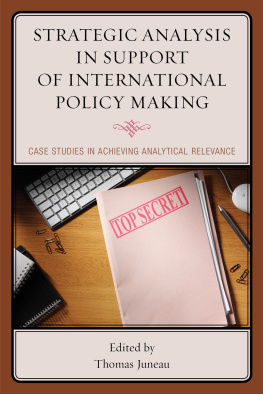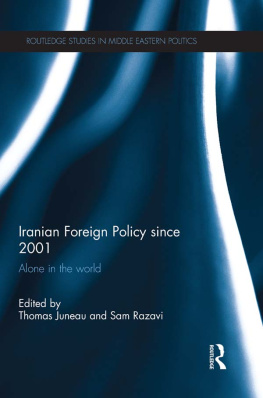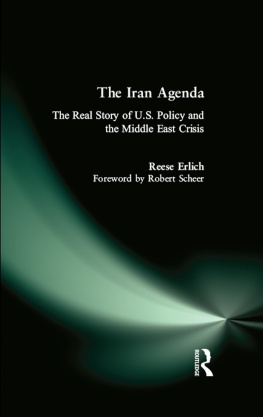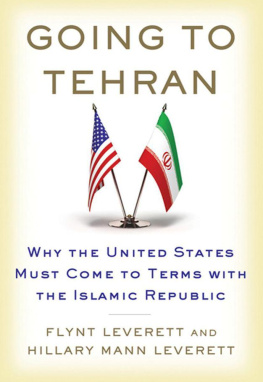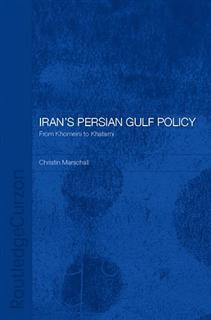Stanford University Press
Stanford, California
2015 by the Board of Trustees of the Leland Stanford Junior University.
All rights reserved.
No part of this book may be reproduced or transmitted in any form or by any means, electronic or mechanical, including photocopying and recording, or in any information storage or retrieval system without the prior written permission of Stanford University Press.
Printed in the United States of America on acid-free, archival-quality paper
Library of Congress Cataloging-in-Publication Data
Juneau, Thomas, author
Squandered opportunity : neoclassical realism and Iranian foreign policy / Thomas Juneau.
pages cm.
Includes bibliographical references and index.
ISBN 978-0-8047-9305-6 (cloth : alk. paper)
IranForeign relations1997 . 2. IranPolitics and government1997 . 3. Political realism. I. Title.
DS318.9.J87 2015
327.55dc23
2014036171
ISBN 978-0-8047-9508-1 (electronic)
Typeset at Stanford University Press in 10/14 Minion
Squandered Opportunity
Neoclassical Realism and Iranian Foreign Policy
Thomas Juneau
Stanford University Press
Stanford, California
I wish to dedicate this book to my wife,
MARIE-HLNE,
and to our two sons,
RMI and PHILIPPE
CONTENTS
Figures and Tables
FIGURES
TABLE
Acknowledgments
I would first and foremost like to thank Brian Schmidt for the extraordinarily valuable feedback and support he gave me throughout the research and drafting process of this book. I also thank Farhang Rajaee and Mira Sucharov, as well as Elinor Sloan and Brian Rathbun, for their advice.
I also express my deepest gratitude to all my superiors at the Department of National Defence with the Government of Canada, where I worked from 2003 until July 2014: Harky Smith, Claude Leblanc, Ben Lombardi, Vincent Rigby, James Groen, Michael Margolian, Martin Green, Col. Brian Irwin, Jean-Franois Morel, and Yves Goulet. Without their help, the inevitable but unfortunate bureaucratic resistance could very well have blocked my dream of pursuing a path combining academia and the civil service. In fact, to be able to have a foot in both the government and academic worlds for all those years was as gratifying an experience as it was fruitful. It is a balance I hope to pursue, in one form or another, in the coming decades.
I also want to thank all of my former colleagues, in Defence and elsewhere in the security and intelligence community, for innumerable arguments over the years on whether Iran is pursuing a nuclear bomb or whether the U.S. or Israel, or both, will attack Iran. These have been invaluable in helping me refine my views on Iran and its role and ambitions in the Middle East. It is partly thanks to those discussions that I steadily evolved toward the conclusion of this bookthat Iran has broadly failed to achieve its foreign policy goals since 2001.
I particularly wish to thank Sam Razavi, a former colleague with whom I co-edited a book on Iran in 2013 (Iranian Foreign Policy since 2001: Alone in the World, 2013). The extensive work that went into preparing this book, as well as our many discussions around shawarma, have been essential in shaping my thinking on Iranian foreign policy.
Even though I joined the Graduate School of Public and International Affairs at the University of Ottawa only three weeks before submitting the final manuscript for this book, I strongly wish to thank the school for having welcomed me in its family. I especially want to thank Peter Jones for his invaluable advice and encouragement over the years. Never again will he pay for coffee in my company.
As I move on to my new career at the University of Ottawa, a special thought goes to professors Grard Hervouet and Jean-Sbastien Rioux, whose advice and support during my masters studies at Laval University in Qubec Cityand ever sincehave been invaluable.
At Stanford University Press, I wish to thank James Holt, editorial assistant, and Geoffrey Burn, executive editor (security studies, international relations, and politics), for their support, advice, and exemplary professionalism throughout the process of transforming the manuscript into a book. I also thank John Feneron, Martin Hanft, and Mary Mortensen for their help at various stages of the production process.
Finally, I wish to thank Marie-Hlne Chayer, my lovely wife, for her encouragement and patience (and exceptional editorial skills). As usual, the responsibility for any mistake or omission is mine.
T.J.
Introduction
The Islamic Republic of Iran faced a highly favorable strategic environment after 2001. A combination of regional and international factors, especially the removal of hostile regimes in neighboring Afghanistan and Iraq, along with the inflow of hard currency resulting from high oil prices, improved the countrys regional standing and led Tehran to assertively expand its interests abroad. Iran, moreover, possesses the necessary assets to position itself as one of the Middle Easts most powerful and influential states by dint of its geography, natural resources, and population. Yet despite these favorable dynamics, Iran failed to seize the opportunity to establish itself as the dominant regional power in the Persian Gulf and as an indispensable player in the Middle East, as its ambition.
How can one account for Irans underwhelming performance? How can one explain that faced with this advantageous set of circumstances, Iran failed to fulfill its ambition to become the dominant power in the Persian Gulf and a leading power in the Middle East? This book develops and applies a new variant of neoclassical realism to shed light on the causes and consequences of Irans suboptimal performance between 2001 and 2009. It will show that rising power drove Iranian assertiveness, as most variants of realism would predict, but that because of the intervention of key domestic pathologies, Irans foreign policy deviated from structurally induced, optimal outcomes. This led to important, negative consequences.
ENTER THEORY
How can different theoretical approaches account for Irans suboptimal foreign policy between 2001 and 2009?
Offensive realism argues that security in the anarchic international system is scarce. States live in uncertainty, as they can never be certain about their neighbors intentions; they must assume that these intentions are, or could become, aggressive. As a result, statesespecially great powersare driven by the system to maximize their power: achieving regional hegemony is the best way to guarantee survival (Mearsheimer, 1990, 2001). States are not reckless expansionists, however. Rather, they are opportunistic aggressors seeking to increase their power at acceptable cost and risk (Walt, 2002, p. 207). Offensive realism rightly emphasizes that Iran, with its power rising, sought to expand its interests abroad. It cannot, however, account for specific choices. Moreover, its sweeping emphasis on power maximization misses out on other aspects of Iranian behavior.
According to defensive realism, anarchy drives states to compete for security, with the intensity of this competition shaped by the offense-defense balance, or the relative ease or difficulty of conquest (Van Evera, 1999). Because this balance often favors defense, states can usually maximize their security by adopting defensive postures. Stephen Walts balance-of-threat theory (1987, 1996) is often recognized as one of defensive realisms main applications. According to Walt, states do not balance against power, as structural realism predicts, but against threat, which he defines as a composite of capabilities, geography, and perception of intentions. Defensive realism correctly claims that Iran, perceiving an acute threat from the United States and its allies, seeks to maximize its security by counterbalancing: internally, by pursuing the development of asymmetric military capabilities and its nuclear program, and externally, by developing ties with Hezbollah in Lebanon, Hamas in the Palestinian Territories, and groups in Iraq. Defensive realism, however, neglects the importance of Irans power; if Irans power had not risen after 2001, its predictions would not be significantly different, since its explanatory emphasis rests on Irans threat perception. Its focus on security explains certain dimensions of Iranian foreign policy but misses out on revisionist and power-maximizing aspects.


